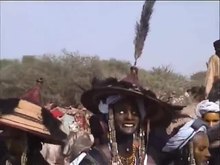Guérewol
Guérewol (var. Geerewol , Guerewol , Gerewol ), (vb. Yeera = to look around ) is a " bridal show festival" celebrated by the Wodaabe , a West African nomad tribe . Wodaabe, also Fulbe Bororo , belong to the ethnic group of the Fulbe and live in Niger , Nigeria , Chad and Cameroon , which is why the Guérewol festival is held in these countries.
The annual festival
Every year in September, at the end of the rainy season , a spectacle returns that marks the climax of the year and is known as Guérewol. For seven days, up to a thousand men gather to hold beauty pageants. These courtship ritual dance events take place in front of the assembled women. It is allowed that the women choose the most beautiful men and touch them. To draw attention to themselves, the women gently rub the men on the back, hoping that they will be chosen as future wives and lovers. A Wodaabe man is allowed to maintain up to four wives, whereby only the first one is chosen by his parents and has to come from a family line (cousin). The Woodabe are known nationwide for their extraordinary beauty.
The Guérewol festival includes three formative dances. It opens with the welcome dance (ruume) . The nocturnal seduction dance (yaake) is considered a very charming spectacle. The competition for the title of the most beautiful is the content of the actual Guérewol (geerewol) . With the Guérewol, the birthright to beauty should be best expressed. This right supposedly comes from the ancestors and is considered unique to an African society.
Ruume
The welcome party (ruume) opens the festivities. Carefully made up and with white turbans on their heads, the men dance counterclockwise in a circle. They sing and clap their hands in unison. Female grace and desire are sung about. The repetitions increasingly aim at a state of trance . Here there are already intimate approaches to the female gender.
Yaake
The actual major dance event is called Yaake . Lesser-known elements of the festival, such as the exchange of trousseau (dowry), various competitions and camel racing events run parallel over days. The men highlight their male ideals of beauty with lavish make-up . Attention is paid to the symmetry and evenness of the applied cosmetics. Ostrich feathers, cowrie snails , leather belts, Fulbehats and ceremonial axes as well as stylish traditional costumes dress the participants. The advantages corresponding to the ideals are emphasized, such as a slim and muscular stature. For beauty ideal includes a tall stature. Other trademarks are shiny white teeth. Impressive whiteness of the eyes is brought out by rolling the eyes . The dance takes place in a slow, pounding rhythm that is accompanied by drum beats. The men stand in a line, shoulder to shoulder. The women stand opposite and examine. Dance and overall performance are taken into account in the subsequent assessment and lead to praise and recognition. The women are allowed to appreciate the characteristics mentioned in detail. You will later decide on the winner. The participants often drink fermented tree bark brews, which increase their stamina in the dances and also have a hallucinogenic effect.
Guérewol
Since the yaake is an elimination competition, the festivity is nearing its climax. The last competitors are equipped with horse tails and form the last dance series for the grand finale. Three unmarried girls form the arbitration tribunal and are introduced to the elders. The performance of the men is examined in a kneeling position and with demurely lowered gaze. After a while, each of the three judges approaches their favorite and signals their decision with a graceful arm swing. The reward of victory is purely immaterial, but it increases pride and admiration.
Cure Salée in Ingall
The Guérewol in Ingall in the Nigerian Sahel is particularly well known . In Ingall the festival takes place as Cure Salée (festival of the nomads). In addition to Wodaabe, Tuareg , who belong to the Berber tribes, also gather here . The Nigerien government has sponsored the festival since the 1990s and sets the exact date and duration of the festivities in order to be able to invite dignitaries and artists and to attract tourists. Furthermore, many residents of the region can be reached in this way, for example, to be informed about health measures.
Individual evidence
- ↑ Derrick J. Stenning (International African Institute), Savannah nomads: a study of the Wodaabe pastoral Fulani of Western Bornu rovice Northern Region Nigeria
- ↑ a b c Beckwith, Fisher, Afrika, pp. 178-195. (see lit.)
- ↑ Kariamu Welsh, Elizabeth A. Hanley, Jacques D'Amboise African Dance
literature
- Carol Beckwith, Angela Fisher Africa. Cults • Festivals • Rituals , Volume 1, CJ Bucher-Verlag Munich, ISBN 3-7658-1243-9
- Mette Bovin: Nomads who cultivate beauty: Wodaabe dances and visual arts in Niger . Nordiska Africa Institute, Uppsala 2001, ISBN 91-7106-467-2
- Willy Lützenkirchen, Peter Carmichael: Bororo: The beautiful men on the »Gerewol« . In: GEO August 1983 , pp. 122-142
Web links
- Guérewol Niger Festival accessed on May 12, 2011
- Niger: Wodaabé wannabes in The Telegraph.Retrieved May 12, 2011
- Wodaabe on YouTube, retrieval repeat June 20, 2011
- Public holidays and festivals p. 76 f. Retrieval on June 20, 2011




